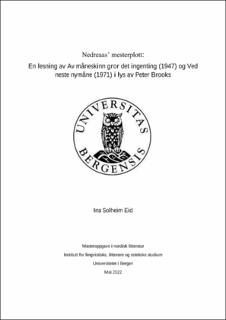Nedreaas’ mesterplott: En lesning av Av måneskinn gror det ingenting (1947) og Ved neste nymåne (1971) i lys av Peter Brooks
Master thesis
Permanent lenke
https://hdl.handle.net/11250/3000803Utgivelsesdato
2022-05-20Metadata
Vis full innførselSamlinger
- Master theses [242]
Sammendrag
I min masteroppgave undersøker jeg to romaner av Torborg Nedreaas: Av måneskinn gror det ingenting (1947) og Ved neste nymåne (1971), og analyserer disse ved hjelp av Peter Brooks’ Reading for the Plot: Design and intention in narrative (1984). Mitt forskningsprosjekt vil bidra til en økt forståelse for Nedreaas’ forfatterskap, og da spesielt hennes bruk av plott og hvordan hun strukturerer plottet. Gjennom plottanalysene viser jeg viktigheten av plottet, og hvordan det kan brukes til å kontrollere leserens forståelse og fremme lysten til å lese. Jeg har undersøkt to romaner med svært ulik oppbygning, men mine funn viser at Nedreaas strukturerer plottene slik at hun fremmer leselyst og vekker leserens nysgjerrighet. Både i Ved neste nymåne og Av måneskinn gror det ingenting blir leserens forståelse kontrollert gjennom bruk av de kvinnelige hovedpersonene som sansningssenter, som fører til naturlige utelatelser av elementer fra plottet. Dette vekker et behov hos leseren for å finne svar, og disse svarene blir gradvis avslørt gjennom plottet. Det er ikke før mot slutten av fortellingen at plottet virkelig gir mening, når leseren når «dødsøyeblikket» i de to romanene, og etter dette vil hele plottet gi større mening sett retrospektivt. Ved å analysere plottet i de to romanene setter jeg søkelys på en ny side ved Nedreaas’ forfatterskap, som tidligere har fått lite oppmerksomhet. Struktureringen av plottet i de to romanene er et viktig med tanke på leseropplevelsen, og noe som fortjener mer plass når man snakker om Nedreaas’ forfatterskap. Nedreaas nyanserer Brooks’ teori gjennom plottingen sin. Hun viser at behovet for repetisjon er mer enn å bevege seg mot dødsøyeblikket. I Av måneskinn gror det ingenting kommer behovet for repetisjon fra den navnløse kvinnens traumatiserte tilstand, og i Ved neste nymåne kommer det fra Herdis’ ønske om å heve seg over repetisjonstrangen, før hun innser at det er ting i livet som hun ikke kan kontrollere selv. In this master’s thesis I’m examining two novels by Torborg Nedreaas: Av måneskinn gror det ingenting (1947) and Ved neste nymåne (1971). I analyse these novels by using Peter Brooks’ Reading for the Plot: Design and intention in narrative (1984). My research project will contribute to a better understanding of Nedreaas’ authorship, especially her use of the plot and her plotting. Through my plot analysis I show how important the plot is, and how it can be used to control the readers understanding and narrative desire. The two novels have a very different structure, but my findings show that Nedreaas structures her plots in a way that promotes the narrative desire. Both novels make extensive use of repetition. In both Ved neste nymåne and Av måneskinn gror det ingenting the readers understanding is controlled through using the female main characters as a focalisation point, which leads to certain elements of the plot being left out in a natural way. It isn’t until the end of the story that the plot truly makes sense, when the reader reaches the moment of death in the two novels. After this the plot will get a bigger meaning retrospectively. By analysing the plot in these two novels I’m looking into a new side of Nedreaas’ authorship, that previously has gotten little attention. The structuring of the plot in the two novels are important, especially when you have the reading experience in mind. This is something that deserves a lot more space when Nedreaas’ authorship is being discussed. Nedreaas nuances Brooks’ theory with the way she creates the plot in her novels. She shows that the need for repetition is more than moving towards the death. In Av måneskinn gror det ingenting the need for repetiton comes from the female main character being traumatized, and in Ved neste nymåne it comes from Herdis’ need to get away from the instinct of repetition until she realizes that there are certain things in life she can’t control.
